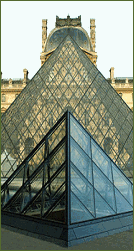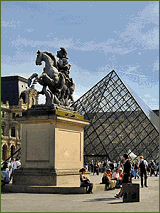|
The building was previously a royal palace and holds some of the
world's most famous works of art, such as Leonardo da Vinci's Mona Lisa, Madonna of the
Rocks, The Virgin and Child with St. Anne, Jacques Louis David's Oath of the Horatii,
Alexandros of Antioch's Venus de Milo and Delacroix's Liberty Leading the People.
Located in the centre of the city of Paris, between the River
Seine and the rue de Rivoli in the Ier arrondissement, it is accessed by the Palais
Royal Musee du Louvre Metro station. The equestrian statue of Louis XIV constitutes
the starting point of the axe historique, and yet the palace is not aligned on this axis.
With over 8 million visitors in 2006 alone, the Louvre is the most visited art museum in the world.
History
Upon the French Revolution, the Royal Louvre Collection (supplemented by the collections
of the French Academy and confiscations from the Church became the "Museum central
des Arts" and opened as this back in 1793.
From 1794 onwards, France's victorious revolutionary armies brought back increasing
numbers of artworks from across Europe, aiming to establish it as a major European museum.
Of particular significance were the addition of masterpieces from Italy, including the
Laocoon and his sons and the Apollo Belvedere, which were both from the papal collection
and arrived in Paris in July 1798. A special vase was even commissioned for this
momentous occasion.
The building was redecorated, inaugurated in 1800, and renamed the "Musee
Napoleon" in 1803. Led by Vivant Denon, it continued to grow through purchases
and forced purchases of part of the Borghese collection, which was an attempt to create a
universal museum of art, with all the best sculptures. But the sheer number of these
statues forced the museum's curators into reorganising the displays and in fact, most of
the art Napoleon directed his commissioners to take was sculpture rather than old-master
paintings.
And for a short period of time, this allowed north Europeans to see the finest of
classical sculpture without organising an expensive Grand Tour to Italy itself, but the
collections shrank again when almost all wartime acquisitions had to be returned after
Napoleon's final defeat at Waterloo in 1815.
Construction and architecture
Philip Augustus founded the first royal Castle of the Louvre in 1190, as a fortified royal
palace to defend Paris on its west against attacks.
The first building in the existing Louvre was begun in 1535, after demolition of the old
Castle. The architect Pierre Lescot introduced to Paris the new design vocabulary of
the Renaissance, which had been developed in the chateaux
of the Loire.
During his reign, King Henry IV added the Grande Galerie. King Henry IV, a promoter
of the arts, invited hundreds of artists and craftsmen to live and work on the building's
lower floors. This huge addition was built along the bank of the River Seine and at the
time was the longest edifice of its kind in the world.
King Louis XIII completed the Denon Wing, which had been started by Catherine Medici in
1560. Today it has been renovated, as a part of the Grand Louvre Renovation Programme.
King Louis XIII also built the Richelieu Wing. It was part of the Ministry of
Economy of France, which took up most of the north wing of the palace.
The Ministry was moved and the wing was renovated and turned into magnificent
galleries. These were inaugurated in 1993, which was the 200th anniversary of parts
of the building first being opened to the public as a museum on 8 November 1793, during
the French Revolution.
The Louvre Pyramid, which is a glass pyramid built in 1989 and serves as the main entrance
to the museum is within the central courtyard of the museum, on the axis of the Champs-Elysees. It was commissioned by
President Francois Mitterrand and designed by I M Pei.
|
|



